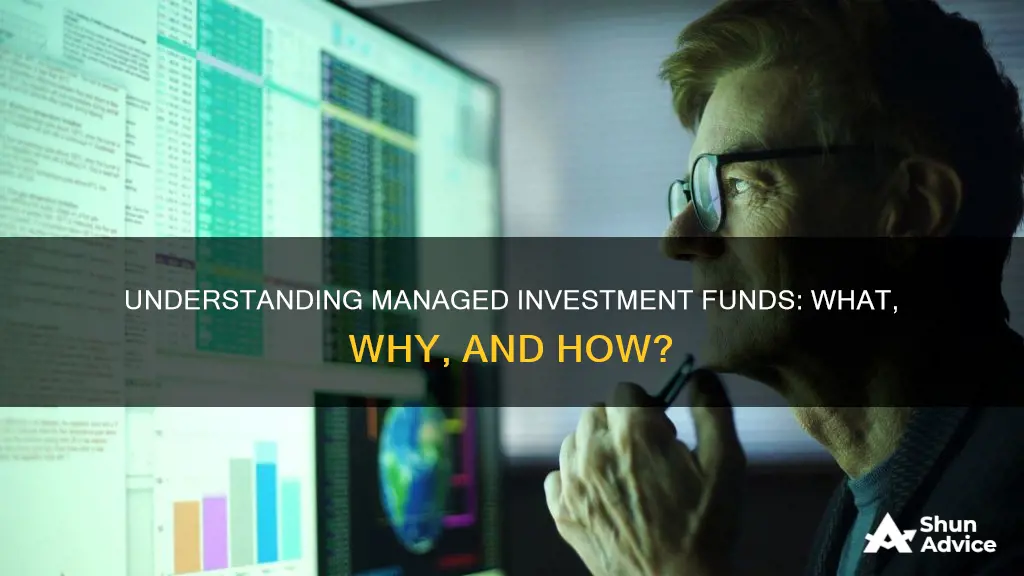
A managed investment fund is a 'registered managed investment scheme', a type of unit trust. It pools investors' money together, which is then used by the investment manager to buy and manage investments on behalf of all investors in the fund. Investors are assigned units proportionate to the amount of money they have invested. Managed funds are an easy way for investors to gain access to a professionally managed portfolio of both local and global stocks.
| Characteristics | Values |
|---|---|
| Type | A "registered managed investment scheme", which is a type of unit trust |
| Investment | The money of individual investors is pooled together and used to buy investments |
| Management | Managed by a fund manager, investment manager or a professional money manager |
| Investment types | Company shares, government bonds, property, cash, stocks, infrastructure, etc. |
| Investor types | Institutional investor or an individual retail investor |
| Access | Through life insurance, pension plans, or directly purchasing units in the fund |
| Control | The manager has the authority to buy and sell assets without the client's prior approval |
| Fiduciary duty | The manager must act in the best interest of the client or face civil or criminal penalties |
| Fees | Annual fee calculated as a percentage of the assets under management (AUM) |
| Investor types | High-net-worth investors, everyday investors, small retail investors |
What You'll Learn
- Managed funds pool investors' money to buy a range of assets
- Investors can access opportunities not available when acting alone
- Funds are managed by professionals, overseen by a Responsible Entity
- Managed funds are open-ended, with units created and cancelled as investors join or leave
- Investors can access managed funds through life insurance or pension plans

Managed funds pool investors' money to buy a range of assets
A managed fund is a 'registered managed investment scheme', a type of unit trust. In a managed fund, investors' money is pooled together and used by the investment manager to buy and manage investments on behalf of all investors in the fund. This allows investors to access investment opportunities that may not be available to them if they were investing alone.
When an investor invests in a managed fund, they are assigned units proportionate to the amount of money they have invested. The fund is open-ended, meaning that new units are created as investors join, and cancelled as investors leave.
The pooled money is spread across a range of assets, such as company shares, government bonds, or property. These managed investment funds can be accessed through life insurance or pension plans.
There are several benefits to this approach. Firstly, it allows for diversification, reducing the impact of fluctuations in an investment's market value. Secondly, it provides access to a broader range of investments that may not be accessible to individual investors. For example, the commercial money market will not give access to an investor with less than $1 million, but through a managed fund, private investors can access this market. Thirdly, the fund benefits from experienced investment managers who can make informed, timely decisions on behalf of the investors.
There are some important considerations when investing in a managed fund. Firstly, there are fees involved in hiring the services of a fund manager, which can impact overall returns. Secondly, like any other form of investment, managed funds are exposed to different levels of risk, so it is essential to understand your risk appetite before investing. Lastly, it is worth noting that actively managed funds do not always outperform the benchmarks they aim to beat, and there is a chance of losing money.
Unlocking Real Estate: The Benefits of Investing in Funds
You may want to see also

Investors can access opportunities not available when acting alone
A managed investment fund is a 'registered managed investment scheme', which is a type of unit trust. By using a managed fund, investors' money is pooled together and used by the investment manager to buy and manage investments on behalf of all investors in the fund.
Pooling funds together allows investors to gain access to investment opportunities that they may not have been able to access if acting on their own. Managed funds can hold up to several hundred different investment types, which can be diversified across countries, asset classes (e.g. shares, property, bonds, cash), industries and companies. This way, investors are automatically diversifying their investment.
For example, the commercial money market will not give access to an investor who has less than $1 million. As a private investor, you can access this market through a managed fund.
Managed funds can also be used to invest in global stocks, which may not be available to individual investors.
International vs Domestic Funds: Where Should You Invest?
You may want to see also

Funds are managed by professionals, overseen by a Responsible Entity
A managed fund is a 'registered managed investment scheme', which is a type of unit trust. The fund manager's job is to pool investors' money together and use it to buy investments, which they manage on behalf of all investors in the fund. Managed funds are overseen by a Responsible Entity, who performs a role similar to that of a trustee in a trust.
The Responsible Entity is responsible for overseeing the operations of the fund, monitoring the fund's investments and market performance, and ensuring the fund pays its operating costs and tax. They may also act as the fund's investment manager or appoint a third-party investment manager.
The investment manager is responsible for selecting and managing the fund's assets. They have discretionary authority over the fund and make investment decisions based on the client's needs, goals, risk tolerance, and asset size. The investment manager will supply the client with regular reports on the fund's performance and holdings.
The custodian is another important role in a managed fund. This is an independent financial institution that physically holds the fund's underlying investments. They act as a check to help insulate the fund from fraud.
Together, these professionals ensure that managed funds are an easy way for investors to access a professionally managed portfolio of local and global stocks.
Invest in Tata Retirement Savings Fund: A Comprehensive Guide
You may want to see also

Managed funds are open-ended, with units created and cancelled as investors join or leave
A managed fund is a professionally managed investment portfolio. It is a type of unit trust, or "registered managed investment scheme", where investors' money is pooled together and used to buy investments. These funds can be accessed through life insurance or pension plans.
When an investor invests in a managed fund, they are assigned units proportionate to the amount of money they have invested. Managed funds are open-ended, meaning that new units are created as investors join the fund and units are cancelled when investors leave. This is a flexible arrangement that allows investors to join or leave the fund as they please. It also means that the fund can scale up or down depending on demand.
The open-ended nature of managed funds allows for a variable number of investors to participate in the fund at any given time. This flexibility can be advantageous for both the fund managers and the investors. From the fund manager's perspective, it provides the ability to accommodate a dynamic group of investors and adjust the fund's size accordingly. For investors, it offers the convenience of being able to enter or exit the fund without being restricted by a fixed number of units.
The creation and cancellation of units in a managed fund are typically handled by the fund manager or a designated entity responsible for overseeing the fund's operations. This ensures that the process is fair and transparent for all investors. It also helps maintain the integrity of the fund by providing a mechanism to account for changes in the number of investors.
The open-ended structure of managed funds provides investors with the flexibility to join or exit the fund as their investment goals and financial circumstances change. It also enables the fund to adapt to market conditions and investor demand, making it a dynamic and responsive investment option.
Muni Bond Funds: A Guide to Investing Wisely
You may want to see also

Investors can access managed funds through life insurance or pension plans
A managed fund, also known as a managed account, is a 'registered managed investment scheme', which is a type of unit trust. Managed funds are portfolios owned by individual investors but supervised by professional money managers. These managers are compensated by a fee, calculated as a set percentage of the assets under management (AUM).
Managed funds pool investors' money together, allowing investors to access investment opportunities that may not be available to them if acting alone. Investors are assigned units proportionate to the amount of money they have invested. The funds are then used by the investment manager to buy and manage investments on behalf of all investors in the fund.
Managed funds can be accessed through life insurance or pension plans. Life insurance plans are designed to provide financial security for you or your loved ones in a time of need. Permanent life insurance, for example, can be considered a financial asset since it can accumulate cash value over time. This cash value can be withdrawn and used in several ways, such as to cover expenses in times of pressing need.
Pension funds, on the other hand, are a collection of pooled assets managed with an organised asset allocation that seeks to earn a return over time to meet pension payout obligations. Pension funds are becoming less popular due to their management complexities, but many government employers still use them. A pension fund manager uses a variety of financial instruments to meet the goals of the fund, investing in stocks, bonds, and possibly structured products.
Both life insurance and pension plans can be used to access managed funds, providing investors with a way to grow their wealth and create another source of income while also protecting their loved ones against unforeseen events.
Mutual Fund Roth IRA: Best Investment Options
You may want to see also
Frequently asked questions
A managed investment fund is a professionally managed investment portfolio. The money of individual investors is pooled together and used to buy assets such as company shares, government bonds, or property. The fund is then managed by a professional investment manager.
Managed investment funds are beneficial for those who don't have the time, knowledge, or skills to make informed investment decisions. They are also a good way to diversify your portfolio as they can hold up to several hundred different investment types, which are diversified across countries, asset classes, industries, and companies.
When you invest in a managed fund, you purchase units in the fund rather than the assets directly. The number of units you own depends on the amount of money you invest and the value of each individual unit at the time of purchase. The unit price will fluctuate along with the market.
There are fees involved when investing in a managed fund as you are hiring the services of a fund manager. The amount of fees can vary but is typically calculated as a set percentage of assets under management (AUM).
There are two main types of managed funds: actively managed funds and passively managed funds. In actively managed funds, the fund manager selects the stocks based on their own convictions, while passively managed funds tend to be lower cost and aim to match the performance of a benchmark rather than beat it.







